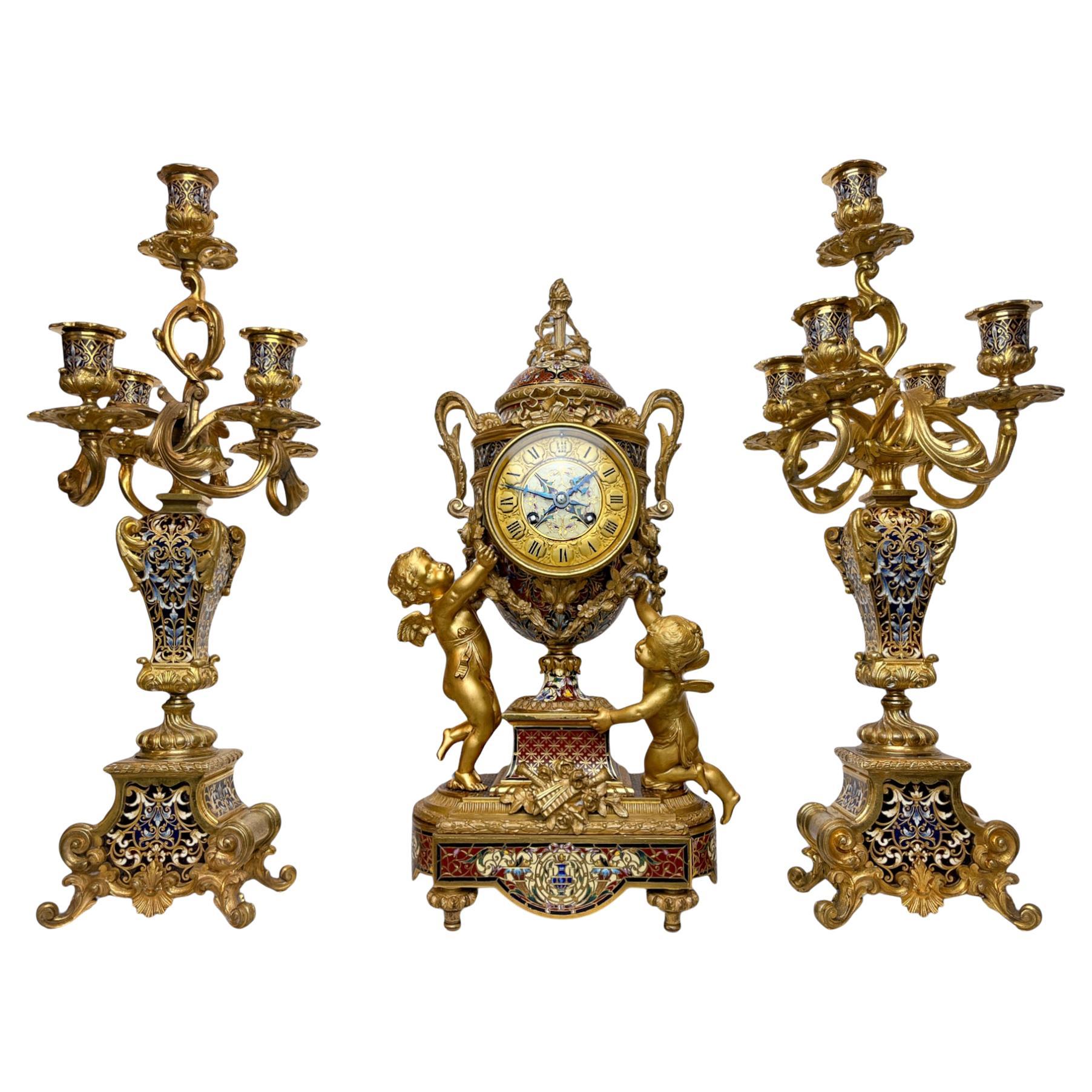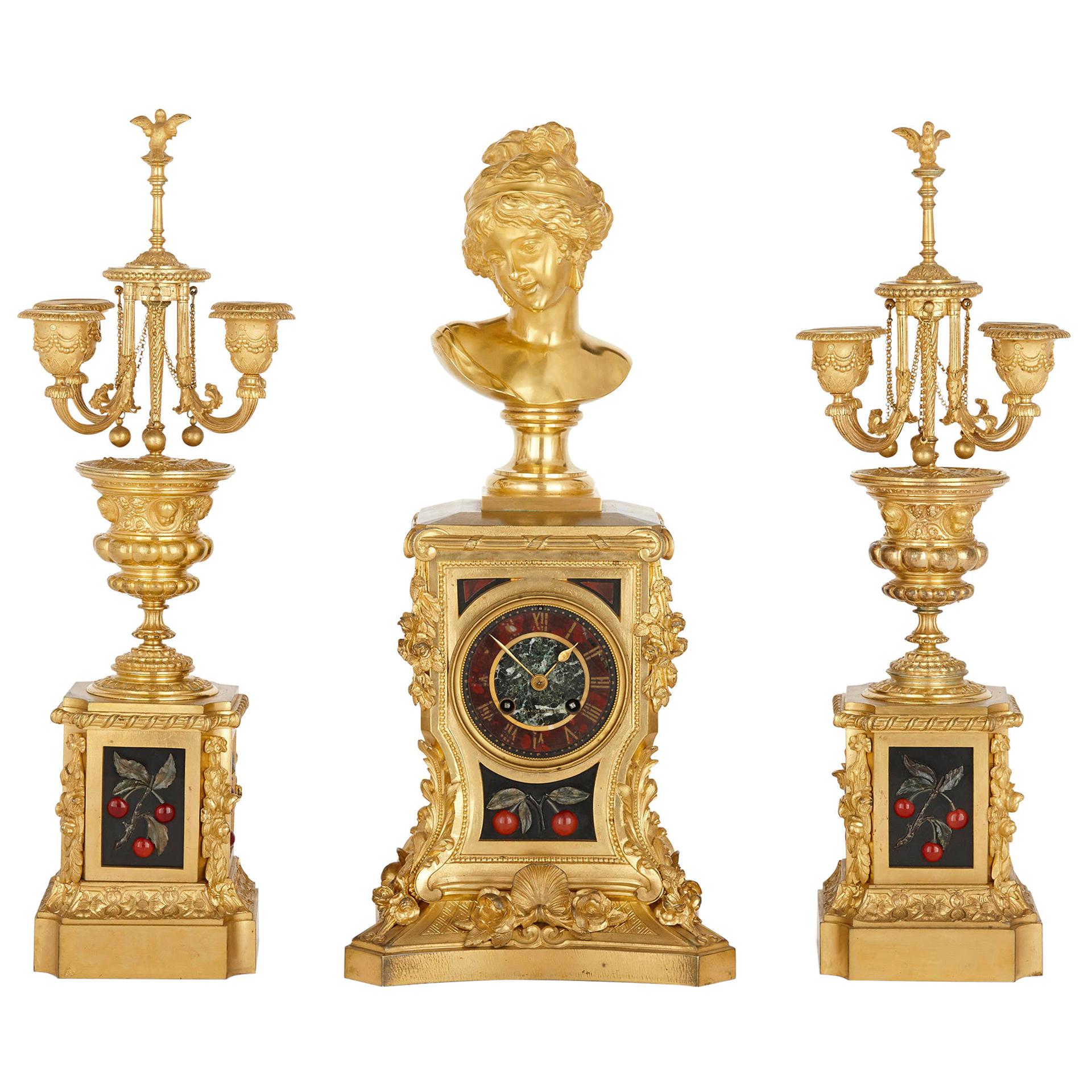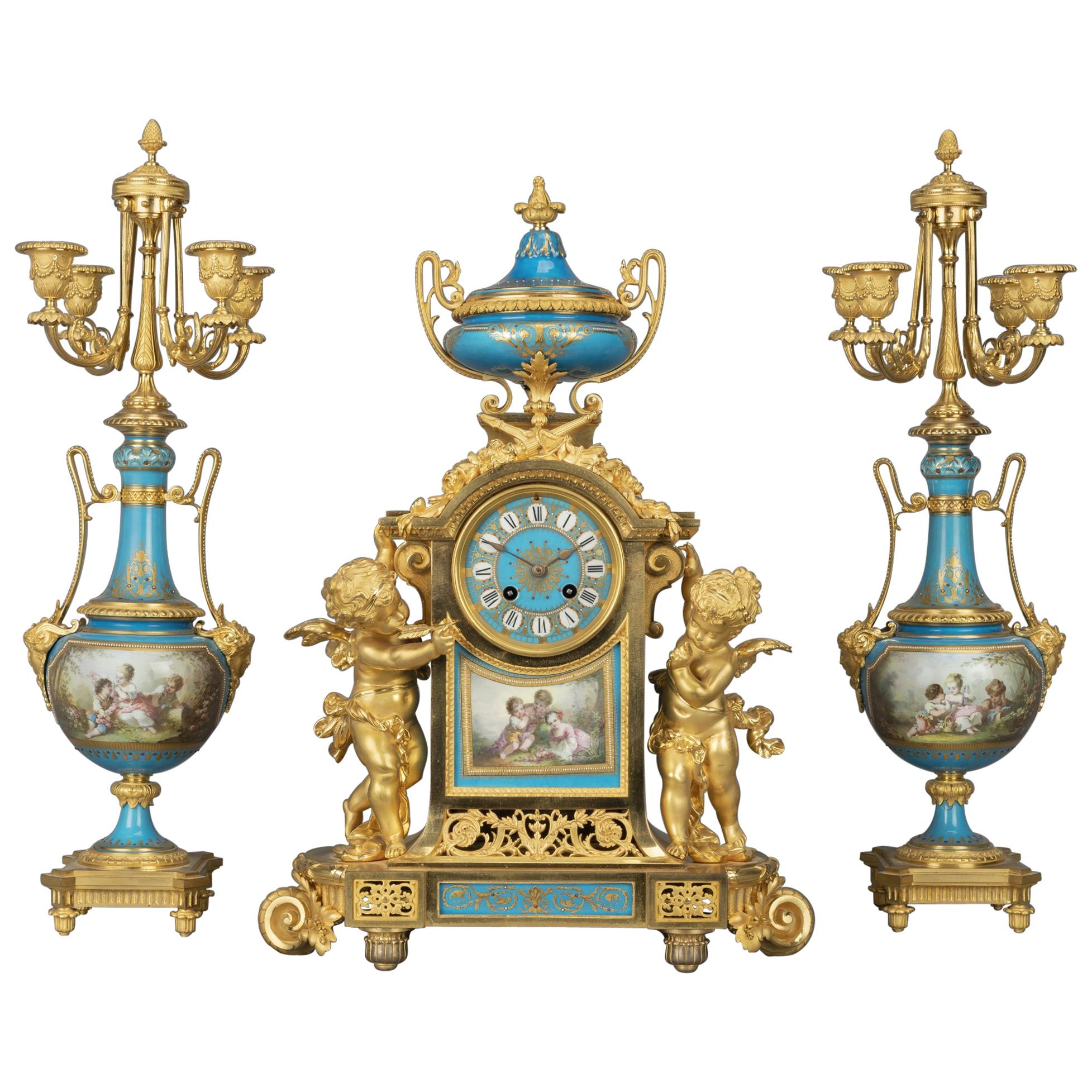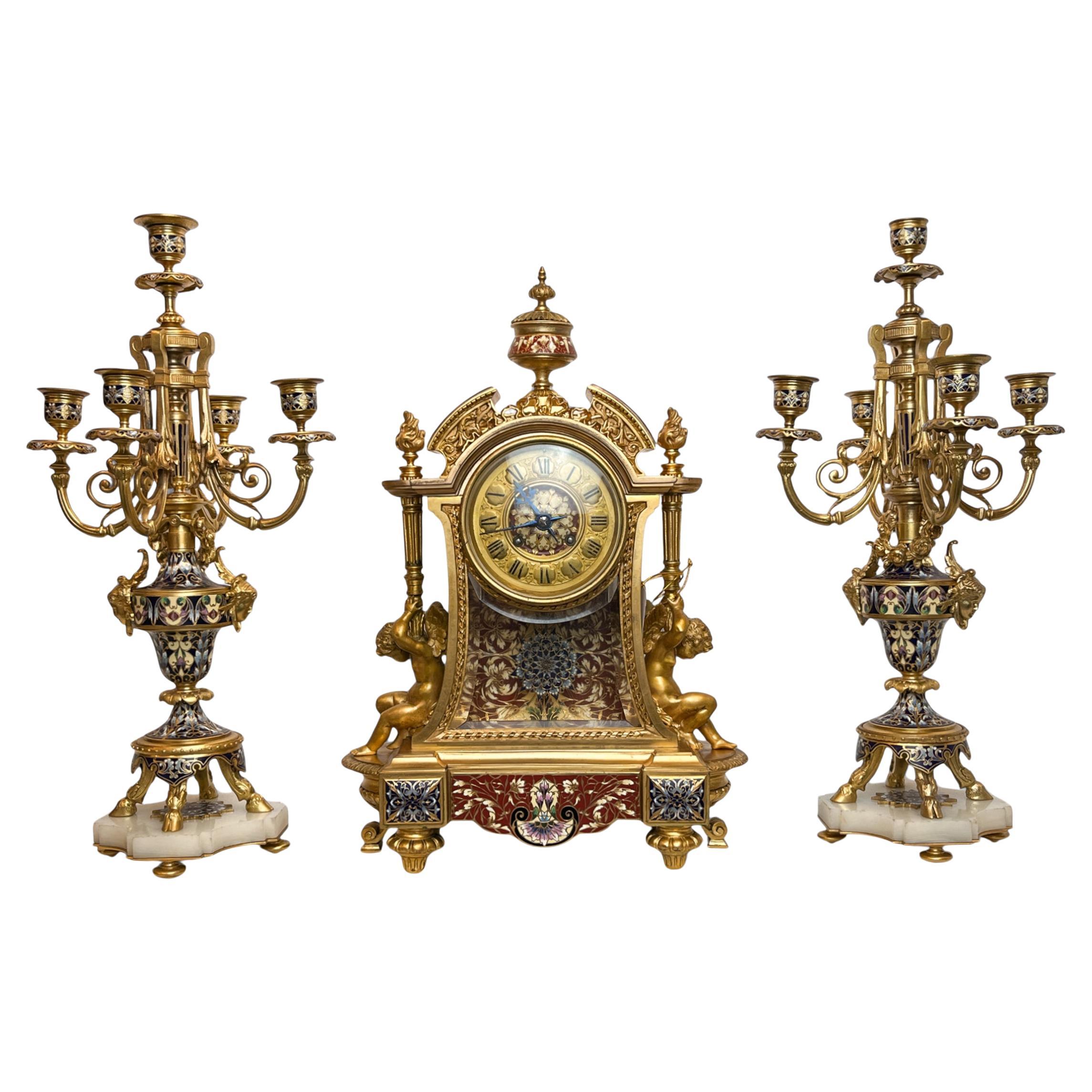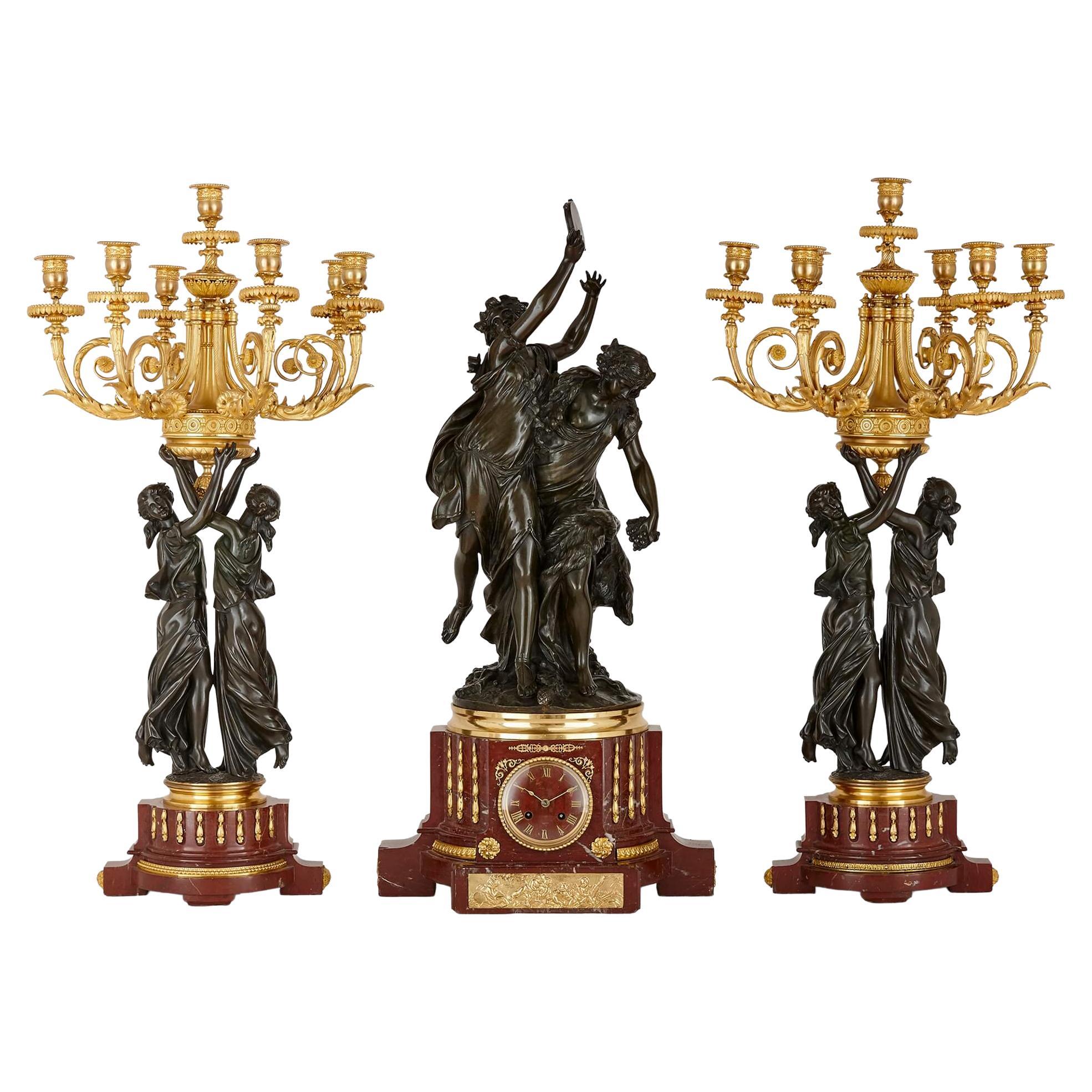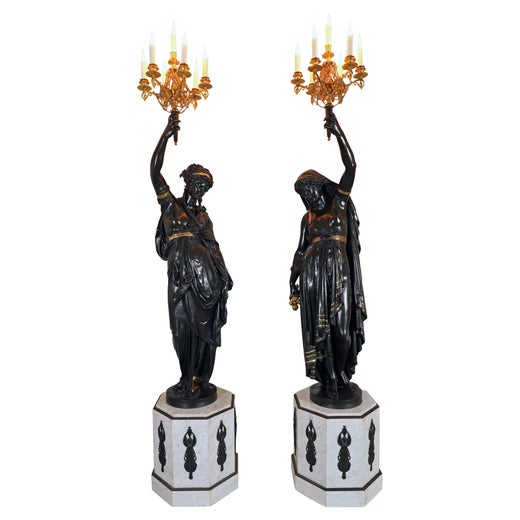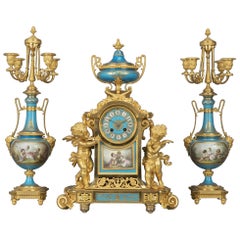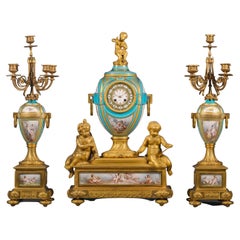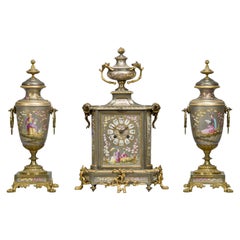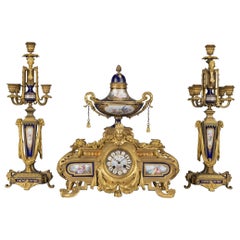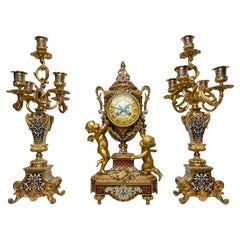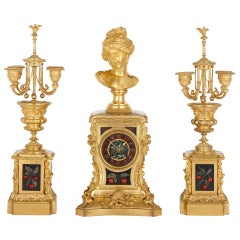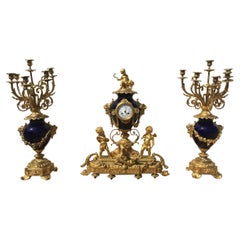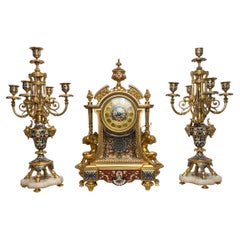A Napoleon III Gilt and Silvered Bronze, Onyx and Champlevé Enamel Figural Three-Piece Clock Garniture. By Eugène Cornu for the Société des Marbres Onyx d'Algerie, the figure cast from a model by Albert-Ernest Carrier-Belleuse (1824-1887), the movement by Eugène Farcot, Paris.
Comprising a mantle clock and a pair of ten-light candelabra. The clock surmounted by a silver and gilt-bronze figure of a neoclassical diaphanous female figure sculpted by Albert-Ernest Carrier-Belleuse. The figure, commonly identified as Urania, the Greek goddess of astronomy, suspends a conical pendulum with star-studded orb weight which rotates in a circular manner around a point at her feet. This is in addition to the traditional movement which operates the clock dial. The dial is housed in a onyx marble case shaped as an architectural entablature and further ornamented by champlevé enamel plaques with geometric scrolled decoration above a stepped onyx base. The clock workings visible through the open dial. The dial is of gilt-bronze with brass hands and Roman numeral markers. The twin barrel movement has a rack striking to bell.
The candelabra are designed en suite with scrolled branches issuing leaf-cast nozzles, all surrounding a central onyx finial. The vase shaped bodies of onyx marble encircled by a champlevé enamel plaque with geometric scrolled decoration and flanked by loop handles. On a gilt-bronze socle and onyx foot.
Signed to the clock dial 'Sté des marbres onyx d'Algérie / Bd des Italiens 24, Paris'. The clock movement with 'EF' monogram for Eugène Farcot.
France. Circa, 1860.
Approximate Dimensions
The clock
Height : 116 cm 46 inches
Width : 48 cm 19 inches
Depth : 29 cm 11 inches
The candelabra
Height: 80 cm 31 inches
Width: 40 cm 16 inches
Depth: 40 cm 16 inches
The beauty and sophistication of Carrier-Belluse's figure is matched by the impressive technical achievement of the conical pendulum escapement by Eugène Farcot. The 'mystery movement' which turns the orb and pendulum held by the figure, also rotates the mechanism controlling the motion of the inner wheels. A pioneering engineer in many fields, Farcot was the most renowned nineteenth century maker of conical pendulum and 'ingenious mystery' clocks, taking out successive patents throughout his long career. Together with the Societe des Marbres Onyx d'Algerie, Farcot exhibited examples of large figural conical pendulum clocks at the Paris Exposition of 1867, at the 1876 Philadelphia Exhibition and at the 1878 Paris Exposition.
The clock base and candelabra were made by the Société des Marbres Onyx d'Algerie and Eug. Cornu of Paris, who mined and fashioned luxurious Algerian marble and were celebrated for the quality of their production and design. The Cashmere onyx to this clock and candelabra is of the finest quality which can be distinguished by its translucency and white colour, free from brown flecks and inclusions. Onyx, known since antiquity and used by both the ancient Egyptians and Roman civilisations, was first shown in modern times at the 1862 International Exhibition in London to great acclaim, having only been rediscovered in 1849 in Oran, Algeria.
This clock movement is of eight-day duration, with two trains, one for the timekeeping and the second for striking. The clock strikes on the hour and the half hour on a bell. The skeletonised movement has a drive running up through the marble case where it has a rotating arm. This arm connects to the bottom of the pendulum, which rotates in a circular motion, governing the turning of the gilt-bronze arm and therefore the speed and synchronisation of the clock. The pendulum is suspended using the Cardan system in order to allow for free circular motion. The dial is of gilt-bronze finely engraved with the maker ‘Sté des marbres onyx d'Algérie / Bd des Italiens 24, Paris’.
Established at rue de Trois Bornes from 1858 - 1890, Farcot took out patents for the conical pendulum in 1865 and 1872. It is recorded that he exhibited it at Paris in 1861, 1867 and 1878, in London in 1862 and at the Centennial Exhibition in Philadelphia in 1876. The distinctive feature of the conical pendulum is that it is in constant motion as opposed to the conventional pendulum which is continuously stopping and starting.
The first record of a clock with a conical (rotating) pendulum is a turret clock by Jost Bodeker in 1587. Its application was later studied by Huygens, who experimented with isochronous conical pendulums, publishing his 'horologium' in 1673. Its first practical application however was almost certainly by Passement in Paris who incorporated it in a clock mechanism to allow a telescope to point continuously at a single star.
The Onyx Marble Company of Algeria was founded in 1858 by Alphonse Pallu, specialising in high-end luxury objects and furniture, often combining Algerian onyx and champlevé enamel. The company worked with some of the most important sculptors and designers of the day, including Albert Earnest Carrier-Belleuse, Charles Cordier and Eugene Cornu (who became its chief designer and director). The company changed names a number of time becoming, G. Viot & Co., E. Horn & Co. and finally H. Journet & Co. It is recorded in the Registres de Commerce et de l'Industrie in 1878 that the head office was located at 29, rue Popincourt and ‘les Magasins de Vente’ at 24, boulevard des Italiens, Paris.
It exhibited at many of the Universal Exhibitions from 1862-1900 with great success:
- International Exhibition, London, 1862
- Exposition Universelle, Paris, 1867, where Viot and Cornu received a gold medal for an important pair of vases made from onyx marble, bronze et enamel and signed by both men.
- International Exhibition, London,1872
- Centennial International Exhibition, Philadelphia, 1876
- Exposition Universelle Paris, 1878, a spectacular array of objects including a lifesize clock by Carrier-Belleuse and Eugène Farcot.
- Union centrale des arts décoratifs, Paris, 1884, where MM. Journet exhibited a torchère with a silvered-bronze figure of a female enveloped in a drapery of cashmere onyx owned by the Marquis de Linarès.
The clock is dominated by the finely cast and silvered, bronze classical figure, wearing a diaphanous draped costume, highlighted in gilt-bronze. Commonly identified as Urania, the Greek goddess of astronomy she holds in her raised right arm a pendulum terminating in a celestial orb which freely rotates in an elliptical axis. The figure is cast from a model by Albert-Ernest Carrier-Belleuse who was one of the most important and renowned sculptors of the nineteenth century, celebrated in his own time for his mastery of design and technical virtuosity. Making his debut at the Salon in 1851, Carrier-Belleuse then worked in England until 1854 in the design shop at Minton's porcelain works in Staffordshire, under Leon Arnoux, where many of his models were produced in ceramic.
Upon his return to Paris in 1855, Carrier-Belleuse rapidly established himself as the premier ‘sculpteur ornamentaliste’ of the Second Empire, embarking upon important projects at the Louvre, the Hôtel de la Païva, the Opera, the Hotel de Ville and the Théâtre-Français. As one of the most prolific and versatile sculptors of the nineteenth century, he made his reputation with the group Salve Regina, which was shown at the Salon of 1861, and later works ‘Bacchante’ (1863) and ‘The Messiah’ (1867) which brought him medals and the Legion of Honour. In the last years of the Second Empire he executed many public commissions and was highly regarded by Emperor Napoleon III, who referred to him as our Clodion (a comparison often made). During the Paris Commune of 1871 he took refuge in Brussels but returned to Paris the following year where he continued to work until his death in 1887.
